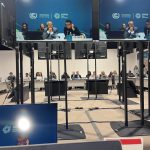Report and photos: Filip Blagojević, youth delegate of RES Foundation in Baku
As the days at the COP pass, we feel the duty, before moving on to the actual negotiations, to convey impressions from some other dialogues and panels we attended.
One of the panels that made us think was the one about capacity building and finding mechanisms for sustainable development and strengthening the climate change resilience of landlocked countries. Our Serbia is among those countries. This was highlighted as of particular importance, since the export and import of these countries takes place exclusively through the territories of other countries and depends on them, which was highlighted as a special vulnerability of landlocked countries, so the need to improve these mechanisms for these countries in the future was emphasized and empower.
In addition, another panel that caught our attention was on the economic potential of the transition to zero emissions and the implementation of the agreement from the previous COP, COP 28. This panel was organized by the International Energy Agency (“IAE”), where some of the panelists were ministers, representatives of the private sector/business and the World Bank. There are some important points highlighted, one of which is that, according to the agency’s analysis, the world will manage to triple the use of renewable energy sources, which is close to the goal set by previous COPs. The importance of the long-term planning of the states regarding climate change was also emphasized, and above all the consistency and respect of what was planned, in other words, that the states stick to what they have planned and not constantly change it. This is important so that the money of the private sector would start investing in climate change, because only joint investment can implement this transition. Investments in business are made for much longer periods, periods of 10 years, and require certain reliability and security. If state plans change every couple of years, it gives the impression of frivolity and uncertainty, which will drag away private sector investments and greatly slow down the transition in this field. The Agency also presented the results of its research that the biggest contribution to the reduction of greenhouse gas emissions would be the implementation of Energy Efficiency measures, which could reduce emissions by a factor of two in the future.
After these great lectures, dialogues and panels that we visited, we started with tours of the negotiation processes themselves, which was a real treat for us (at least for our delegate 😊 ). One of the first negotiations we visited was the “New collective quantified goal on climate finance” negotiations, a topic and negotiations that were announced as a real “boom” and the main goal of this COP. The goal of these negotiations was to create and designate mechanisms for financing and investing in the combat against climate change, primarily mechanisms for developing countries. The start was scheduled for 19:00, in front of the hall there was perhaps the greatest interest of observers yet. We managed to arrive among the first while the line behind us was huge. We were waiting for the negotiations to start, but that never happened, they were previously postponed until 19:00, but now that time has already passed. Delegates and negotiators arrive “nonchalantly” and relaxed, as if they are going to participate in some “leftist” negotiations and not those that should result in an agreement that will certainly determine the way the world functions and looks in the future. When everyone arrived, they informed us that there was no room in the hall and sent us to another room where the video transmission of these negotiations was on. We arrived in that room, sat down and the negotiations officially began. The Chairperson asked if anyone had anything to add to the draft text, Great Britain came forward and highlighted some of their considerations. And that was it, the chairman announced the end of the negotiations and said that a new meeting would be held the next day with a certain addition, and after that the text would be sent to the “presidency” for adoption, the main body. The long-announced “boom” negotiations lasted only a few tens of seconds, they were announced for the next day at 10:00 a.m. with that addition. The next day the situation was a little better, but not much; the parties gave their impressions on it and asked for additional time to review the amendments. The official negotiations have been completed, the parties have had time to send their suggestions until 3:00 p.m. and at 5:00 p.m. they will be sent to the “presidency”. Since that sequel was unofficial and far from the eyes of us observers, what was decided and sent remains to be seen…
We were afraid that other important negotiations would continue in this manner, but that was not the case. In the following posts, we will present to you the impressions and processes of the other negotiations, which really deserved that word because they were quite intense, competent and full of twists and turns.





